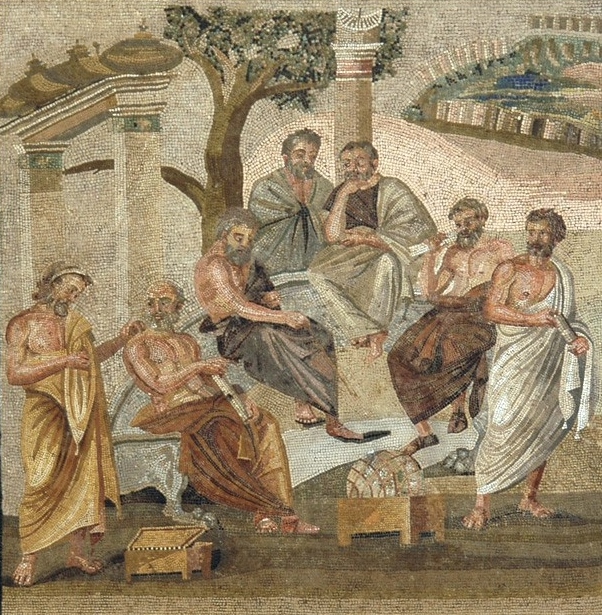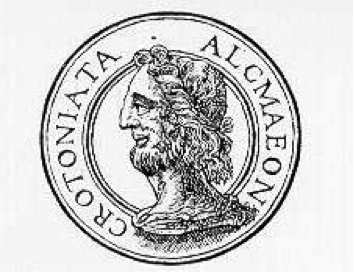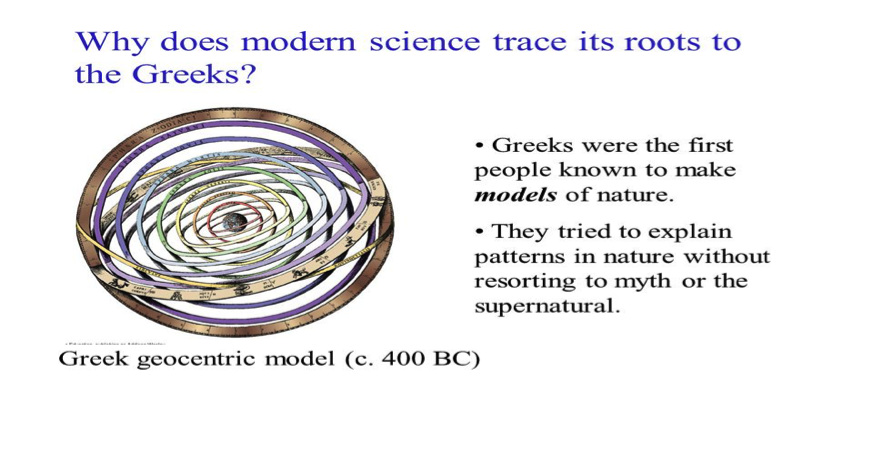By David Hooker, Contributing Writer, Classical Wisdom
As I read and re-read the philosophers, tragedians, poets, and other commentators of the ancient world, I am constantly amazed. The insights they came up with regarding natural and speculative philosophy, nature (and human nature), and the universe oftentimes drop my jaw! More than anything else, it’s stunning how close they were to our modern understanding of physics, the universe, and much of the knowledge we take for granted in the “settled” scientific world we live in today.
It was the pre-Socratic philosophers (Thales, Anaxagoras, Parmenides, Pythagoras, Heraclitus, Empedocles, et.al.), however, that really set the stage for all of the great, critical philosophy to come. I like to call their era the “Big Bang” of Western philosophy, as these guys were really “on to something.”

The Philosopher’s Mosaic, villa at Torre Annunziata near Pompeii
They didn’t possess all the wonderful scientific tools we have today (the electron microscope, the Hubble Space Telescope, etc.) to better understand nature and our universe, but they, by mere reasoning and daring to ask critical questions, came up with astonishing insights. Here is a brief overview of three pre-Socratic philosophers you’ve likely never heard of, who, nevertheless, were really “on to something”.
Hermotimus of Clazomenae
Hermotimus (ca. 6th Century BC) was a member of the Ionian League and hailed from near Smyrna (modern Izmir) on the west central coast of what is today Turkey. Unfortunately, like many of the more obscure pre-Socratics, none of his original works is extant. As such, we rely on mentions by other philosophers and writers, such as Aristotle, to provide us with information about their thinking.
Hermotimus is credited with being the first philosopher to propose the stunning idea that mind is fundamental in the cause of things. He submitted that physical entities are static, while reason causes change. This sounds remarkably similar to one of the critical axioms of modern day quantum mechanics: that the human mind is an active player in “creating” the reality we perceive.
For instance, the Heisenberg uncertainty principle states that it is impossible to know simultaneously the exact position and momentum of a particle. That is, the more exactly the position is determined – from human perspective – the less known the momentum, and vice versa. Wrap your mind around that, dear reader! At the quantum level, nature is always in flux and unpredictable; chaotic in a sense. By observation and participation, we humans stamp our sense of “order” onto it, and it is thus a random universe to which we bring meaning.

The Uncertainty Principle
Sextus Empiricus, a 2nd century AD philosopher and physician, places Hermotimus with Hesiod, Parmenides, and Empedocles as belonging to the class of philosophers who held a dualistic theory, that of a material and an active principle (reason) together being the origin of the universe (cf. Aristotle’s “Unmoved Mover”). While I don’t believe Hermotimus had anything like quantum mechanics in mind (he was likely presaging Aristotle’s “Unmoved Mover” in cosmology – a Creator, or First Cause in creation), he was definitely “on to something.”

Alcmeon of Croton
Born in 510 BC, Alcmeon was a contemporary of Empedocles and Anaxagoras. While none of his works is extant, we have comments from Aristotle and Theophrastus to enlighten us. Alcmeon was considered a brilliant physician of his day and lived during a transitional period in Greek medicine. While traditionally medicine was wed to philosophy and religion, it took a dramatic turn in the sixth century BC.
Alcmeon was a pioneer in the strictly empirical method of diagnosis, as opposed to the more “generalist” approach of his predecessors, who attributed a disease or problem to some transgression against a god. Instead, Alcmeon looked at the individual and wanted identifiable facts: how do the senses function in the case? Why does the patient present as so? What are the symptoms actually telling us?

He introduced his doctrine of physical equilibrium (isonomia) to define and explain the state of health in the patient. Alcmeon performed detailed physiological investigations of the different senses in order to explore the actual causes of the sensations and symptoms presented. Moreover, he thought that the human body should be “in balance” in a healthy person. Four aspects, or “powers,” of cold, hot, wet, and dry should naturally be in balance in the human body. If any of them gets out of whack, problems present. While primitive, this “four humors” pathology persisted well into the Middle Ages… And remember – physicians were blood-letting routinely as recently as two centuries ago!
The important thing is that Alcmeon set the stage for future physicians with the focus on the patient’s sense information and how he/she presented. What did those symptoms say? His efforts to focus on empirical data, with a mind to keep the patient in equilibrium, were seminal in the advance of the medicine of his era. Alcmeon was definitely “on to something.”
Diogenes of Apollonia
Diogenes of Apollonia, born 460 BC, is often considered the last of the pre-Socratics and seems to have done most of his important work in Athens. He was influenced by Anaxagoras’ doctrine of Mind, and was indebted to the atomists’ view that coming to be and passing away were caused by the mixing or separating of elements of the same kind. Following Anaximenes, he proposed the physical theory that all things in the world are modifications (heteroioseis) of the same basic stuff: Air.
The assertion that everything in the universe is a modification of a single basic substance was made by Diogenes on the force of two related considerations: 1.) physical interaction would be impossible if each individual thing were radically and substantially different from everything else, and 2.) the uniformly exhibited harmony of nature would be a mystery if an underlying, all-pervasive intelligence did not control and guide everything. To deny these considerations would be equivalent, Diogenes thought, to ignoring the ways in which things mix, or help or harm each other, as well as the way things depend on each other (as in water to a plant, or any living thing breathing air). It would be tantamount to overlooking the balance, measure, and intelligible structure that characterize every aspect of nature.
Diogenes asserted that air is the basic cosmic substance, since it is the life principle and intelligence of the whole animate world. In his thought, air is the source and guiding power of every physical change. It is the most versatile and adaptable substance. Its capacity to manifest itself in a wide variety of forms, and under every conceivable condition – hot, cold, wet (humidity, vapor), and dry – is evidence of its rationality and divinity. To the extent that there is air in all animation, a part of God is in every living creature.
While we moderns don’t share the ancient notion that “earth, air, fire, and water” comprise the basic cosmic substances (we have a catalogue of 118 elements that comprise nature, as of 2017) there’s no question that Diogenes was “on to something.” Diogenes, in his time, was working in a period of transition in Greek thought. He attempted to reconcile ancient insights with new discoveries and bring pre-Socratic speculations inline with the systematic details of biological and natural observation.

The late, great cosmologist and astrophysicist Carl Sagan was very impressed by the ancient Greek thinkers. (Dear reader: if you haven’t read any of Dr. Sagan’s great books or seen his “Cosmos” series on DVD, what are you waiting for?!) He speculated that had they been allowed to continue to flourish, we as a human species would have become a space faring civilization centuries before the modern era. Think of that, my friends! And the bedrock of their scientific and philosophical ideas and speculations was formed by the pre-Socratics. Most certainly, they were “on to something.”









No comments yet. You should be kind and add one!
Our apologies, you must be logged in to post a comment.